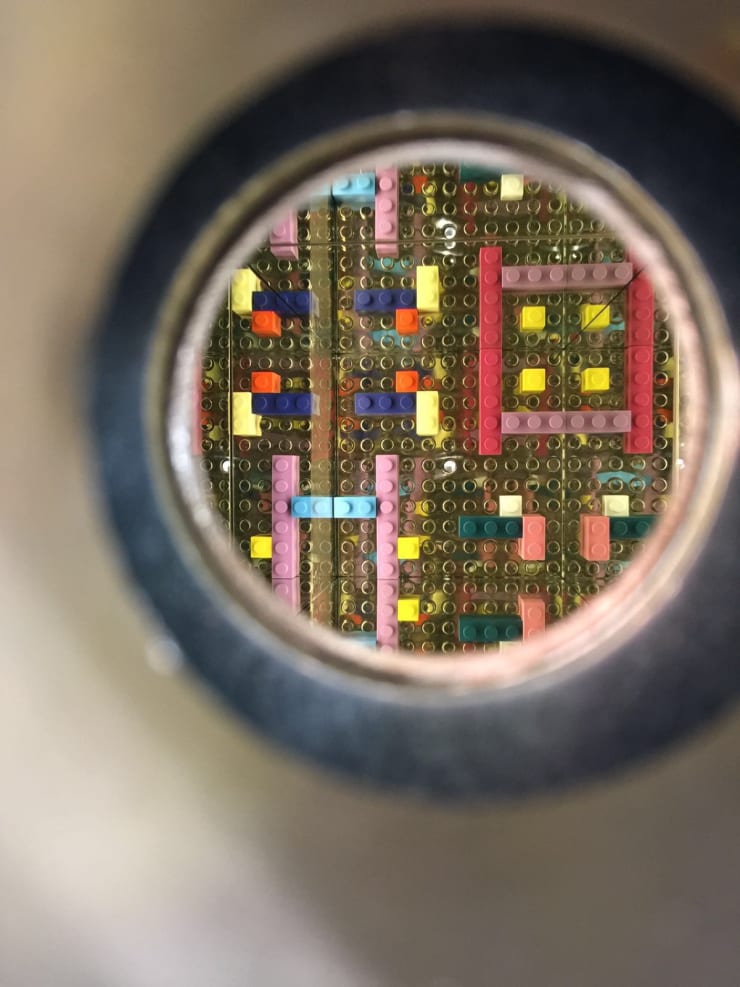UNCERTAINTY PRINCIPLE - ABSTRACTION AFTER ABSTRACTION
curated byIvan Quaroni
14 June - 23 September 2016
Vernissage: Tuesday 14 June, at 18:30
Via Venti Settembre 11 A - 16121 - Genoa - Italy
During the opening, Charlie will be presenting Ruins of memories, a new album born from memories, written and thought of as a gesture of the hand as it cleans the old dust from old diaries and found photographs.
Six artists of the Millennium generation rethink the code of abstract representation, occupying the Genoa's art gallery spaces with polysemous signs and gestures, between expanded painting, sculpture and environmental installation.
Uncertainty principle studies the birth of a new abstract and polysemous sensitivity, expressed through a variety of mediums: painting, sculpture and installation, in discontinuity with the classic abstraction codes, geometrical, informal or analytical. The curator Ivan Quaroni identified six artists, born between 1979 and 1987, who developed a mainly aniconic language, even if there are cases where the relationship with figurative styles haven't been completely cut off. What distinguishes this group of artists is the recognition of the basic ambiguity of visual language and, therefore, the final dismissal of the dichotomy between abstraction and representation, a legacy from the past.
In 1986, the American abstract painter Jonathan Lasker wrote: "I'm seeking subject matter, not abstraction." Lasker thought Abstraction was dead with Frank Stella's Black Paintings, so he imagined painting as representing marginal topics like memory, presence, matter, transcendence and the mix between high and low art. In addition to these topics, felt as crucial nowadays, the post-abstraction by the Millennials, shaped by the exponential growing of information and digital technology, reflects on the individual's position during image creation and fruition processes.
The channels and timings of perception in painting (as well as in sculpture and installation), was a central matter in the avant-garde research by Zero Group and Azimut and analytical painters during the Seventies. What appears as a distinctive factor in these studies is that they all come from individual experiences.
The title Uncertainty principle refers to the epistemological consequences of Heisemberg's theory in scientific research. It becomes an excuse to underline the radical subjectivity of the artistic studies by the Y generation and, at the same time, it highlights how this subjectivity crosses codified limitations, to get into a syntactic and casual, ambiguous and undetermined dimension.
Paolo Bini (Battipaglia, 1984) translates physical and mental landscapes in abstract chromatic units, based on pixels and scanner or plotter timings. The artist paints on paper strips, then mounted on boards and canvases (or walls), to create images characterized by a parallel, rhythmical and chromatic partition. With paintings, installations and paint-sculptures, Bini builds a lyrical and personal variation of pattern painting, where geometrical precision and gestural urgency of abstract expressionism coexist peacefully. The works by Isabella Nazzarri (Livorno, 1987) are inspired by phyto-morphic and anato-morphic forms. Using an organic and perpetually changing alphabet, she expresses memories, intuitions and mental images, incomprehensible in any other way. The artist gets inspiration from the classification of anatomical and herbal tables to build a world of evocative and fluctuating pictograms, obtained crossing mental structures with natural morphologies. For this occasion, Nazzarri realized a big mural painting on the gallery ceiling, a concentric and crowded genesis of alien organisms, echoing the codified forms of her great canvas paintings and watercolor papers. Matteo Negri's (San Donato Milanese, 1982) research focuses on plastic substances in an eclectic way, in combination with stone and ceramic, metal and resin, creating pop shapes and colors for an immediate expressive efficiency. His varied production centers on the division between form and meaning, a short circuit of aesthetic content and substance. This is the case of Kamigami Box, big irregular boxes showing internal surfaces covered with mirroring steel. The surfaces reflect the Lego constructions on the sculpture's base ad infinitum, giving the impression of a limitless urban settlement. Together with a new Kamigami, the artist shows a piece of furniture, containing many, small unexpected surprises. The mechanisms of creation and image fruition are at the center of Patrick Tabarelli's (Verona, 1979) work.
His works drive the observer towards a kind of perceptive uncertainty, thanks to their formal ambiguity. His paintings are made of flat, almost digital surfaces, or are crossed by dynamic and minimal oscillations, in contrast with the gestural origins of his style. Recently, his works focused on the construction of drawing machines, digital hardware and software for the production of surfaces, which look like hand-painted. So, the ambiguity between author and work emerges once again. Viviana Valla (Voghera, 1986) elaborates the language of geometrical abstraction through unconventional substances, like recovery papers, post-it, scotch and fragments of printed images. She invents an intimate dimension with the realization of a mysterious and enigmatic visual diary. Her works are partially hidden by various layers of acrylic chalk and develop a geometrical structure monochromatically imperfect, where clear areas alternate with surfaces showing howcolor dissolves into brushes and fragmentary modules. Giulio Zanet (Colleretto Castelnuovo, 1984) reports moments of everyday life, reflections and considerations over the nature of experience, without using recognizable forms or narrative approaches. His pictorial language is based on a process of formal abstraction: it is impossible to objectify thoughts ad emotions. His works show uncertain shapes, segments, repetitions. The locked motif of decoration is fused with a free and gestural, rough and imperfect disposition. These shapes find a vital expressive impulse in its fragile balance between rules and transgression. In the exhibition, there are many works breaking the picture's usual structure, invading the gallery walls and floors, like fragments of an expanded painting located into the environmental space.












